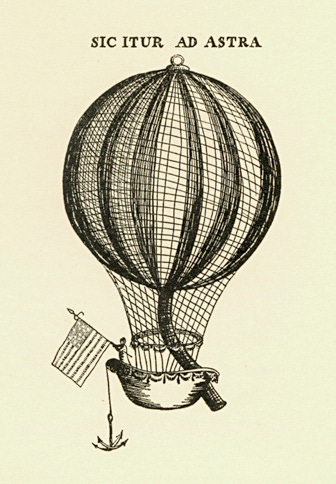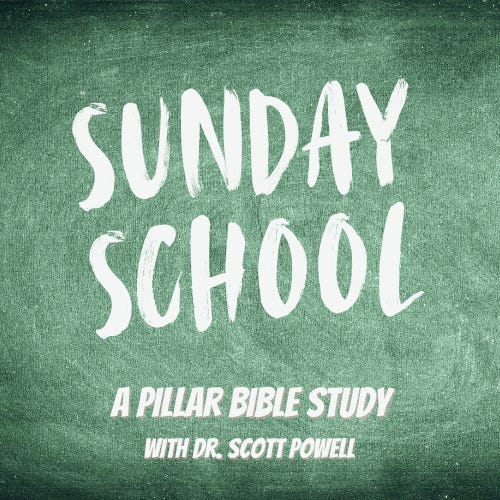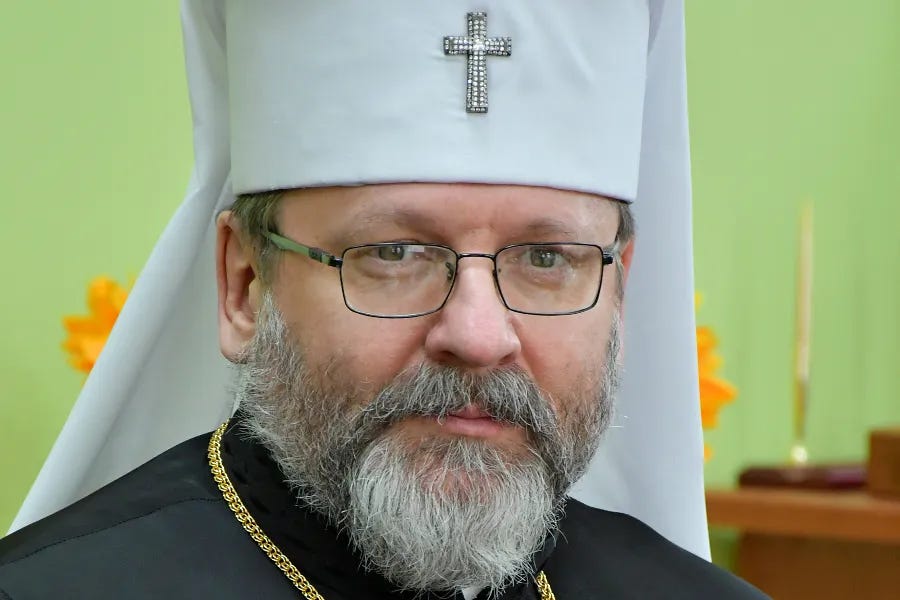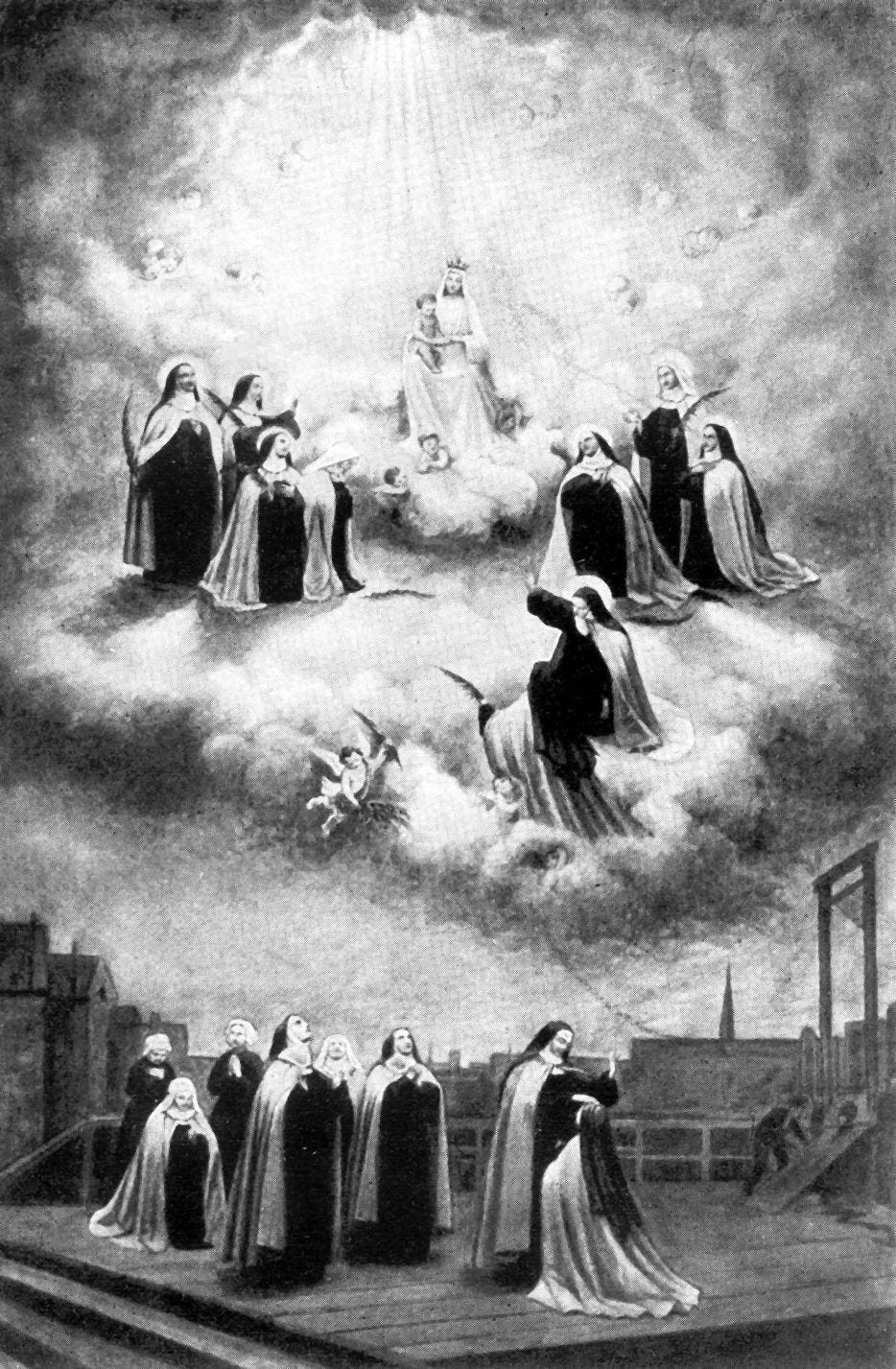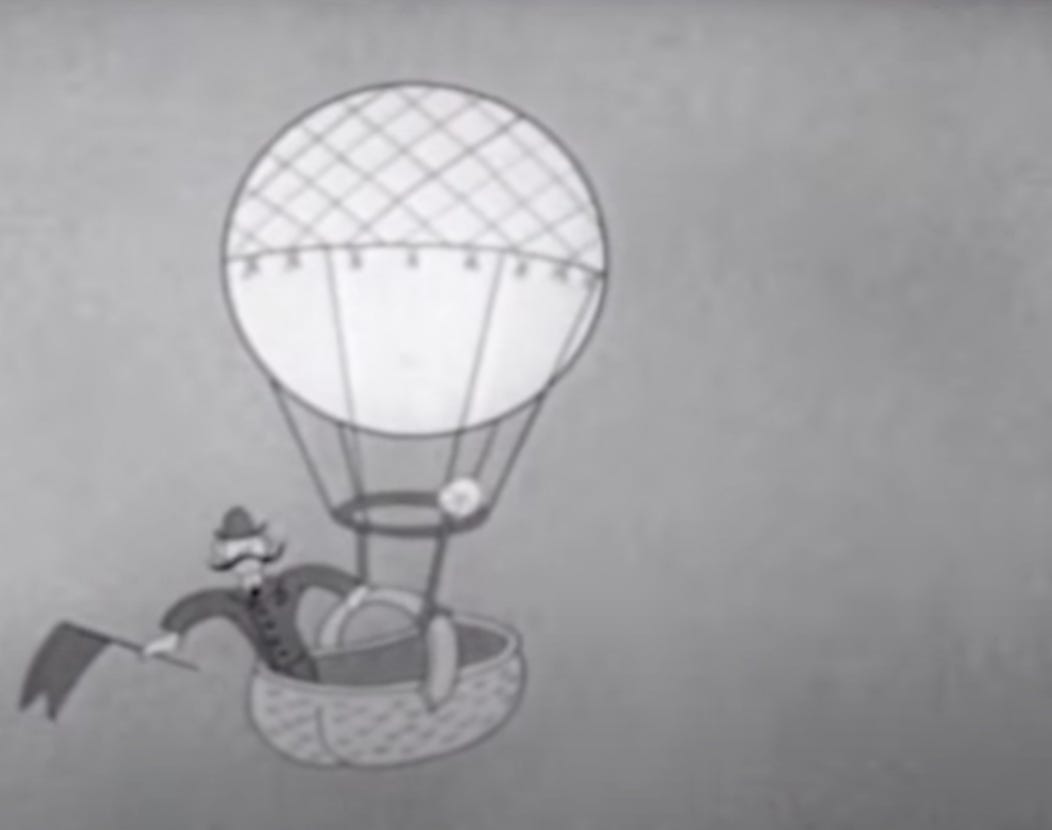
Hey everybody,
Today is Tuesday of the First Week of Ordinary Time, and you’re reading The Tuesday Pillar Post.
But before we get started with the news, I thought you’d like to know about Jean Pierre Blanchard, and the first balloon flight in the United States, which took place 230 years ago yesterday, on Jan. 9, 1793.
Blanchard was a French adventurer and inventor who had first distinguished himself across Europe by crossing the English channel in a hydrogen balloon in 1785. Before and after that flight, he toured the Continent doing balloon exhibition flights, and helping to set off a kind of “balloon-mania,” in which balloons and balloon-shaped decorations become the fashion just about everywhere.
While Blanchard wasn’t the first to fly balloons, he was among the most famous, because he had a knack for drawing a crowd, and a flair for the dramatic. He was, for example, among the first people to incorporate the use of the newly-invented parachute into his balloon shows — for the first few years, he pushed a parachute-wearing dog out of his balloons, but eventually one of his hydrogen balloons got a tear, and Blanchard had occasion to parachute himself into a crowd, to its roaring approval.
Naturally, the balloon daredevil of France found his way to America, and on Jan. 9, 1793, he gathered a huge crowd at Walnut Street Jail in Philadelphia, including the men who would serve as the first five presidents of the United States: George Washington, John Adams, Thomas Jefferson, James Madison, and James Monroe.
Blanchard didn’t speak much English, and he really couldn’t control exactly where his balloon would land, so when he took off, he carried with him a note from George Washington, which asked any American who found him on the ground to “receive and aid him with that humanity and good will which may render honor to their country.”
He probably didn’t need the note. Blanchard landed about 45 minutes after he took off in south Jersey. The first person who found him was quite frightened, until Blanchard offered him a couple glasses of wine, and the two hit it off pretty well. But the second person to find Blanchard’s balloon had been tracking it since it fell from the sky, and he came with a musket raised and ready into the clearing where it had settled.
He was, after all, tracking basically a UFO.
Accounts say that when he saw the balloon, and Blanchard, he dropped his gun and raised his hands in a gesture of surrender. Blanchard, being French, recognized the surrender immediately, but it was rare for his people to be on the receiving end, of course.
Still, presumably, more wine followed, and soon Blanchard got the farmers to take him back to Philadelphia, where he presented to George Washington the first U.S. flag to fly airborne over the country.
Blanchard hung around in the U.S. for a few more years, then he went back to France, and married Sophie Blanchard, who herself became a balloon adventurer.
In fact, both Blanchards died in the skies, as it were. Jean Pierre had a heart attack in 1808 and fell out of a balloon. Sophie died in 1819 when a firework, part of her own pyrotechnics show, collided with her hydrogen balloon, which crashed onto a housetop. Sophie survived that crash, but the fire burned through the balloon’s rigging, spilling her basket, and she died falling just two stories onto the street below.
Anyway, here’s the news:
The News
We’ve covered pretty extensively in this last week the life, death, and legacy of Pope Benedict XVI. But Benedict XVI’s liturgical theology deserves its own report, and here it is.
The truth is that you can’t really appreciate Benedict’s impact on the intellectual life of the Church if you don’t appreciate his work on worship. As one scholar told us, “Benedict XVI fundamentally and irreversibly changed the way the Church understands divine worship, and the effect of that radical renewal is only just beginning to be seen.”
Of course, the fact of the matter is that the Church is still interpreting the liturgical instruction of the Second Vatican Council, and it's doing that with more than a few bumps along the way. How does Benedict impact that work? And what does his liturgical theology mean for the future?
Read about it right here. Really, if you’re interested in liturgy, readers, don’t miss this one.
Start your day with Starting Seven - a daily news roundup in your inbox.
—
And if you are interested in liturgy, you’ve probably already read something about the intense disagreements in the Eastern Catholic Syro-Malabar Church over liturgical rubrics.
It might be hard to believe, but those disagreements have involved street brawls, burning cardinals in effigy, and a liturgical showdown that saw rival liturgies offered on the same altar, an altar dragged across a sanctuary by protestors, and an entire basilica eventually shut down and padlocked by police.
To be clear, there are 4 million members of the Syro-Malabar Church, and the disagreements are all centered in one diocese. But that diocese is the largest in the Syro-Malabar Church, and most prominent. And the disagreement has implications for the whole Syro-Malabar Church, because of the leading bishops involved, and the Vatican’s involvement in the whole affair.
Perhaps paradoxically, Luke Coppen pointed out this week, the Syro-Malabar Church is one of the most dynamic parts of the Catholic Church. Its evangelical influence is increasingly felt far beyond India. But as the liturgy war rages with no end in sight, its internal communion, its inner vitality, is being gravely damaged.
So how does all this end? What can be done about a Church split over whether to celebrate its liturgy, the Holy Qurbana, ad orientem? What can Pope Francis do?
📰
—
I suppose our coverage this week is taking a kind of tour of liturgical issues the world over, because this next report is a very interesting read covering a Ukrainian debate over the liturgical calendar.
Here’s the story: Byzantine Christians in Ukraine - both Ukrainian Eastern Catholics and Orthodox believers - follow the “Julian calendar,” which was the common liturgical calendar of all Christians until the 16th century, when Pope Gregory XIII introduced the “Gregorian calendar,” which is now observed by nearly everyone in the West, Catholic and Protestant alike.
To make things more complicated, other Orthodox Christians in most parts of the world follow the “revised Julian calendar,” which has some things in common with the Gregorian, and some in common with the “old Julian.”
This all means, of course, that different Churches have different dates for different holidays — the Gregorians and revised Julians have a common date for Christmas, for example, while the Julians celebrate it weeks later — but the Julians and revised Julians have the same date for Easter, which is different from the Western date.
This is, in the best of times, kind of confusing — especially in Ukraine, which has a lot of mixed denominational families, who end up keeping a couple of calendars.
But in the midst of Russia’s war on Ukraine, all this calendar stuff has become very political. The Julian calendar, you see, is affiliated with Russian liturgical culture, and with Moscow itself. For some Orthodox in Ukraine, this is no problem, but for other Orthodox parishes, and for most Eastern Catholic parishes, sharing a liturgical calendar with Russia has come to seem inappropriate — and a move to switch both the Eastern Catholic and Ukrainian Orthodox calendars to something else is well underway.
Of course it’s not easy to just change liturgical calendars — it involves changing a lot of customs and habits, and a lot of secular and ecclesiastical politics. But the move to make a shift has a lot of support.
So how is all of this playing out in Ukraine? Our intrepid Ukrainian correspondent, Anatolii Babynskyi, brings you the story — and trust me, if you’re interested in the nexus of global politics and liturgical calendars, The Pillar is the only place for you.
Of course, that’s why you subscribe, right?
Here’s what happened:
Shortly after the funeral of Benedict XVI, a video began circulating online which purported to show a man denied the Eucharist at the Mass, as he knelt and attempted to receive on the tongue.
The video flew all over social media, and soon showed up in very prominent blogs, traditionalist-oriented news sites, on the videos of well-known YouTube provocateurs, with many people saying, in one way or another, that the video was evidence of liturgical opposition to traditional piety in “FrancisChurch.”
Now, of course, there are a lot of facts that aren’t known, and weren’t when the video circulated: if the man was Catholic, if he was suitably disposed to receive, if he had already received, etc etc. There was even a kind of unusual part of the video, in which the man, depending on your perspective, either attempted a second time to receive the Eucharist, attempted to kiss the priest’s hand, or attempted to bite it.
Who can say?
What is clear is that it wasn’t a policy of the Holy See that people should be denied the Eucharist while kneeling or receiving on the tongue, I myself watched scores of people receive kneeling, and I received on the tongue myself.
Either the priest himself — one of hundreds of concelebrants asked just before the Mass to help distribute the Eucharist — didn’t give the man Communion because of his posture, with no legal standing to do so, or there was more to the story.
Not a global issue, not an issue of policy, but certainly it quickly became a PR issue, precisely because it feeds a narrative that already exists among both a set of sincerely disaffected Catholics, and among those who craft, sow, and enflame ecclesiastical persecution narratives for their own purposes.
And indeed, it has actually been the case in some places in the Church that restrictions on receiving on the tongue, implemented during Covidtide, have become more-or-less permanent, to the frustration and disappointment of some Catholics. And the change has, in some cases, been for theological reasons, namely a school of liturgical thought which thinks receiving on the tongue is superstitious or pharisaically pious.
So I asked the Vatican press office, twice, if it would clarify whether the Holy See knew what happened, whether it would look into it, and if, in fact, Catholics are permitted to receive on the tongue at the Holy See. It was my expectation that the press office, or Sala Stampa, could easily clear up an issue that, I am certain, will continue to be mentioned for years by a set of Catholics who have difficulty trusting the good faith of the Holy See.
The Sala Stampa didn’t comment, and hasn’t commented.
And that’s what this analysis is about.
Here’s the gist:
Small issues become big issues in the life of the Church when they go unaddressed. The Holy See is facing criticism for its failure to be transparent, or just, on matters like the Rupnik affair, and others, and yet there seems to be little change in its posture toward answering questions — namely, that the Holy See often declines comment on issues in which comments could allay genuine concerns, and that approach is impeding its good faith efforts toward ecclesiastical reform on major issues, like financial accountability and clerical sexual misconduct.
Will that change? I’m not sure. I do know that soon after the funeral, priests celebrating a different Vatican liturgy were reminded that Catholics should be permitted to receive kneeling and on the tongue.
But the affair, to me, seems like something of a Vatican “own goal” — a minor issue, which in the absence of clarity will become an ongoing point of contention, raised as an official Vatican position or as an example of systemic hostilities. As it circulates online, pastors and catechists will be asked about it by actual parishioners, who are actually upset — when a few comments would likely have put the whole thing to rest.
Anyhow, you can read the analysis here. Let me know what you think.
—
In Nigeria: ‘Swimming against the tide’
Finally, an important story out of Nigeria, where Christian persecution has become the most important story leading up to the country’s February general election.
Bishop Matthew Kukah of Sokoto preached on Christmas Eve a homily calling for a new political and social movement of solidarity among Nigeria’s Christians, as the bishop said a “new caste system” is emerging in Nigeria in which:
“A majority of its children are swimming against the tide for survival with no support, while the other caste smiles in the comfort of their life jackets.”
The bishop, a member of the Vatican’s Dicastery for Integral Human Development, urged Christians to push back against persecution as “a dubious jihadist culture has held our nation to ransom with the government simply looking away.”
Here’s what Kukah is getting at, and why it matters:
It is, I think, well known among The Pillar’s readers that there is probably no more dangerous place to be a Christian right now than Nigeria. Violence against Christians there means that whole villages are being burned to the ground, with children burning in their beds before they can run from their homes.
But Kukah is getting at a different point than the violence itself — namely, the failure of the Nigerian government to intercede meaningfully before and after terrorist attacks.
Christians, especially in Nigeria’s north, don’t only face violence in the country: They face employment discrimination, housing discrimination, difficulty getting loans and credit, and difficulty educating their children.
They also say they face discrimination by police and law enforcement agencies, and by the courts. A January attack which killed 40 people, for example, was not stopped, even after villagers in Nigeria’s central region told police that a suspicious band of men was camping in the forest outside their town.
They called the police and said something was wrong, and their village was burned anyway, by men who had purchased military grade weapons, from somewhere unclear.
And, leaders say, even when state and federal leaders know who commits acts of terrorism, they don’t arrest them or try them — either because officials are sympathetic to the aims of terrorist groups, or because they fear what will happen if they step in.
In either case, Kukah’s point is that Christians in many parts of Nigeria can’t get protection or justice from the people elected to lead. That’s what he means by a caste system - state tolerance of violence against persecuted groups.
And there is growing fear that northern Islamist political factions will move to continue enshrining policies of tolerance and discrimination in Nigeria’s federal courts and agencies if they win next month’s election. Kukah says his people have to push back.
But is it too late? What will happen if Nigeria transitions more concretely from a secular state of Christians and Muslims to a country which officially restricts the lives and practices of Christians? That’s not a far-fetched question — a set of Nigerian politicians and other leaders are talking about the importance of integrating Islamist principles into the federal government even now — and the consequences could be dire.
In the next few weeks, The Pillar’s Fr. Justine Dyikuk will be reporting on this, and how the Church is responding, in a country where the Church is growing very, very fast.
Stay tuned, guys. This is important.
—
Finally, since I gave you a brief sketch of America’s hot air balloon history, I thought you might be wondering how balloons actually work.
Here’s what you wanted to know, in just two minutes:
And here’s a cool video from New Mexico’s annual International Balloon Festival:
Sorry, I guess, for all the hot air in this newsletter.
Have a good week.
Be assured of our prayers, and please pray for us. We need it!
In Christ,
JD Flynn
editor-in-chief
The Pillar
PS: If you think of it, forward this newsletter on to someone who would like it, or sign them up - for free - to get The Pillar Post in their inbox. You're how we grow!
And for no particular reason, here’s the best indie-type Eminem cover I’ve heard in a while, if you like that kind of thing:

